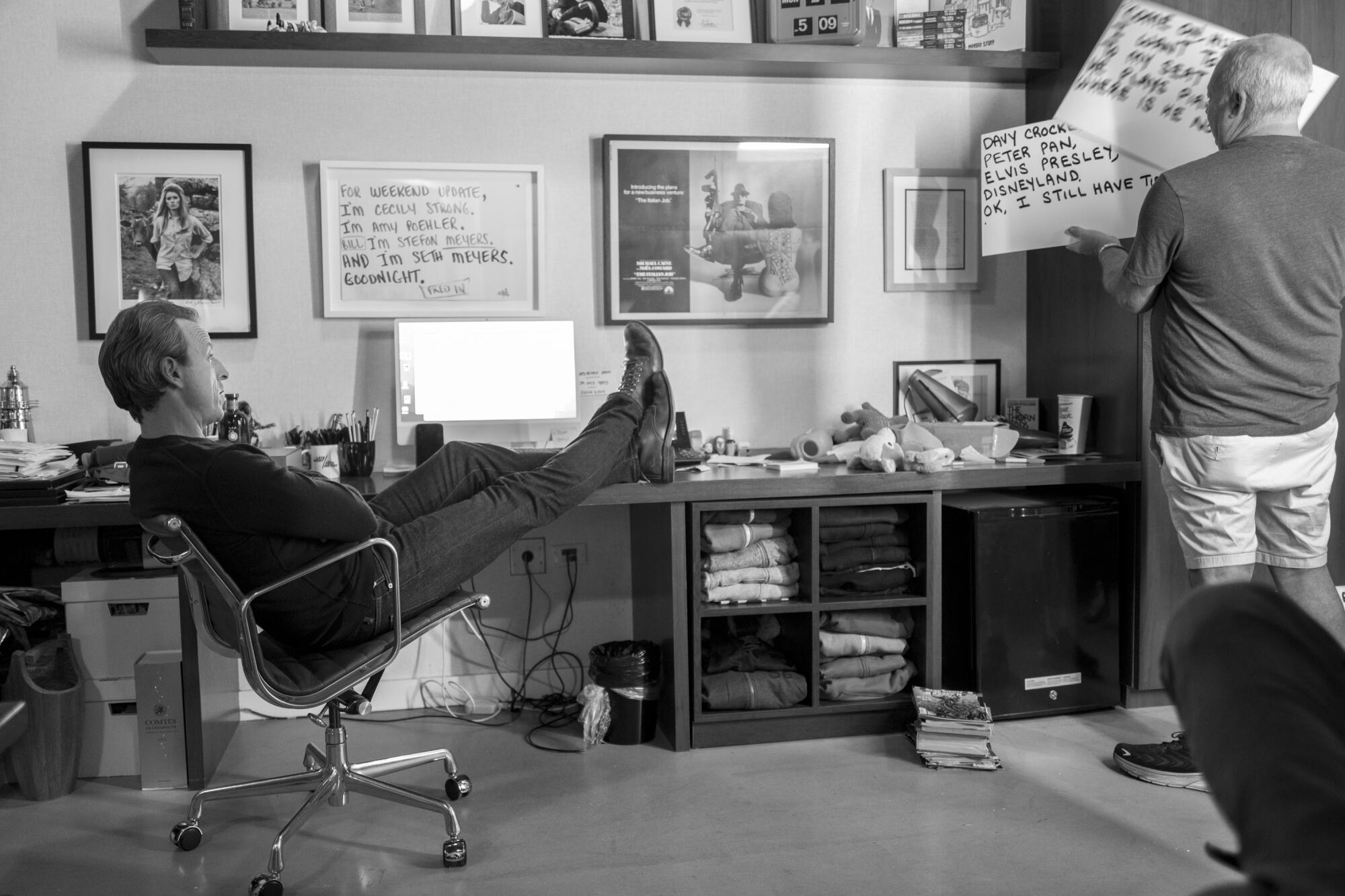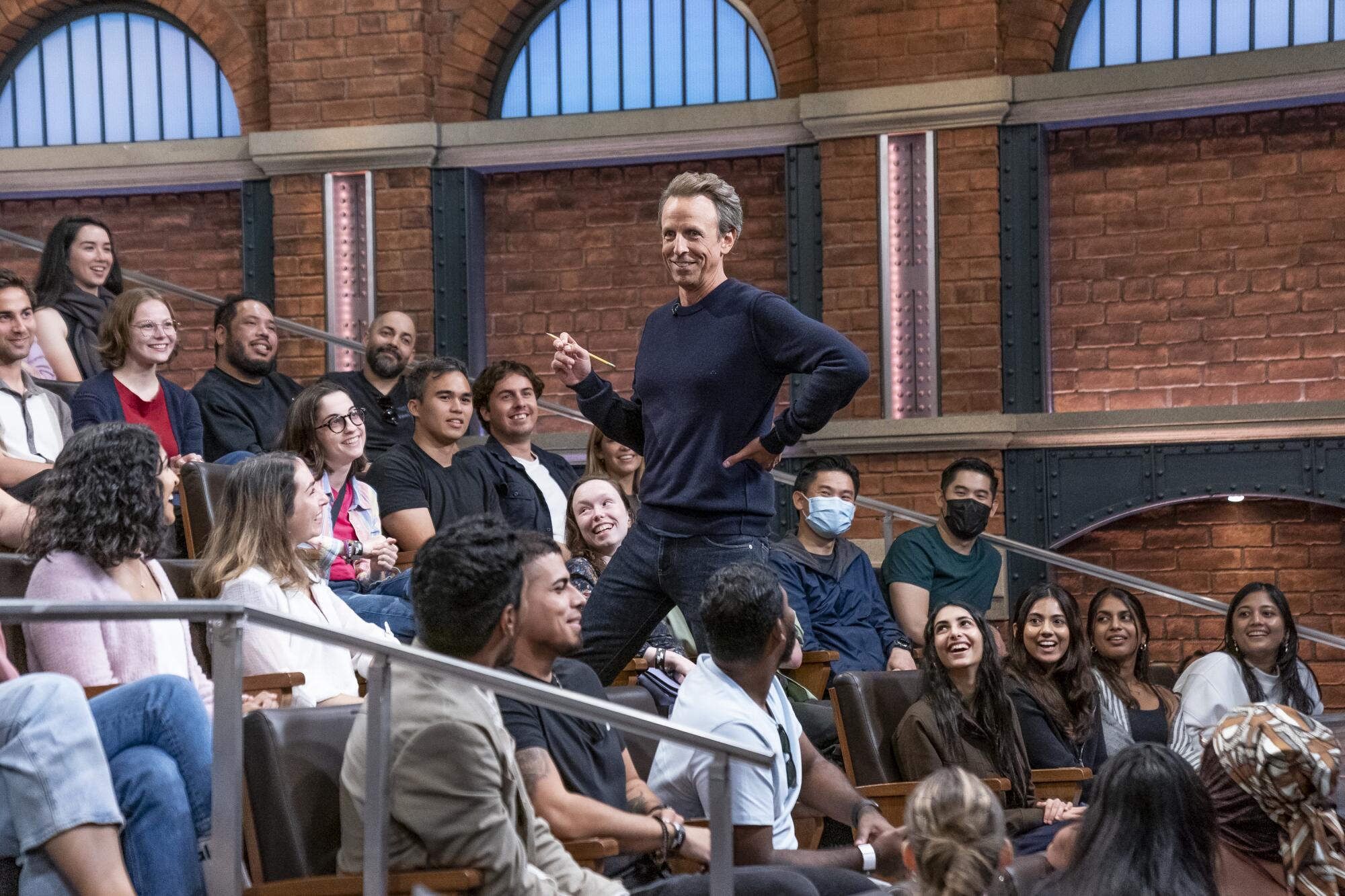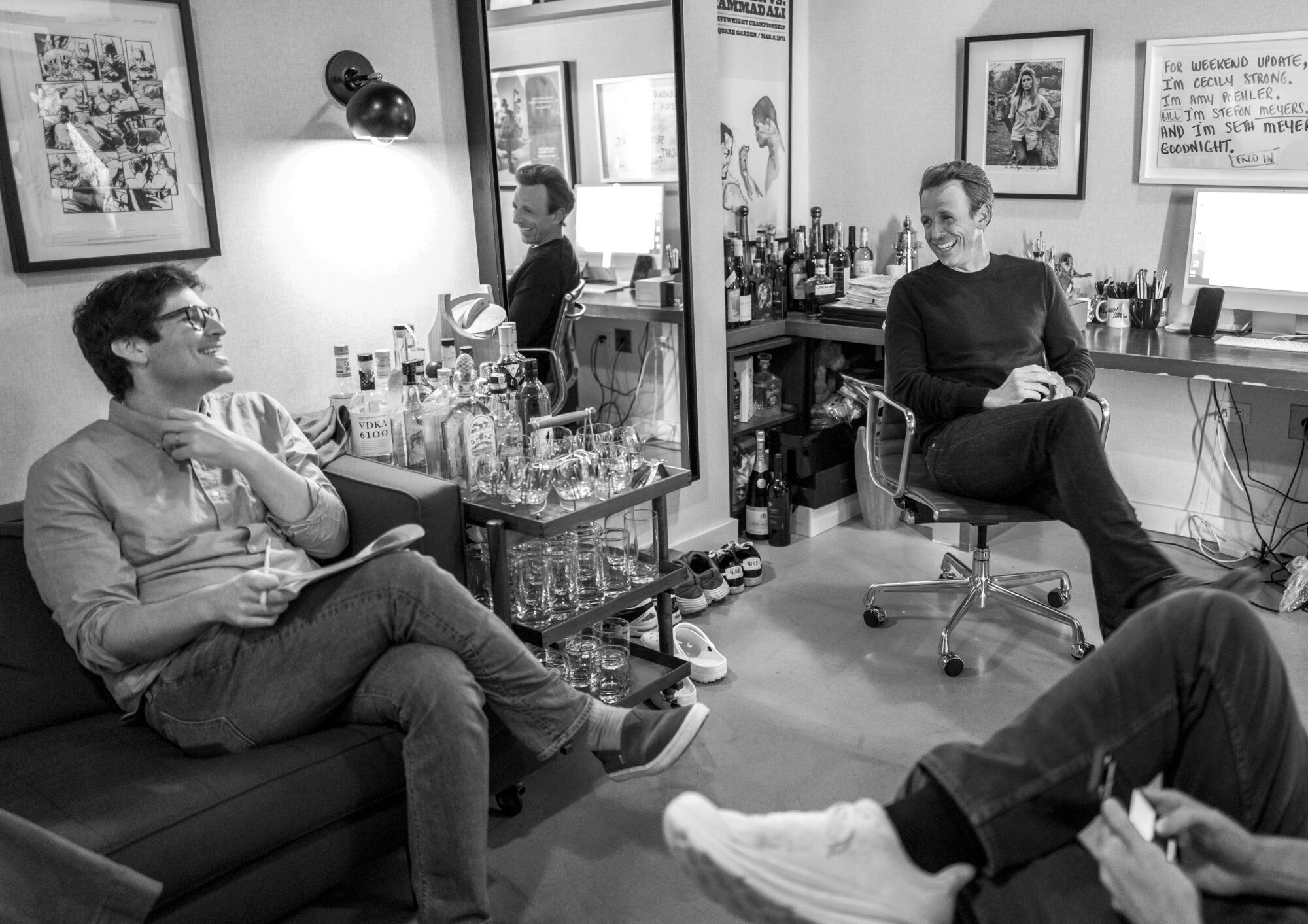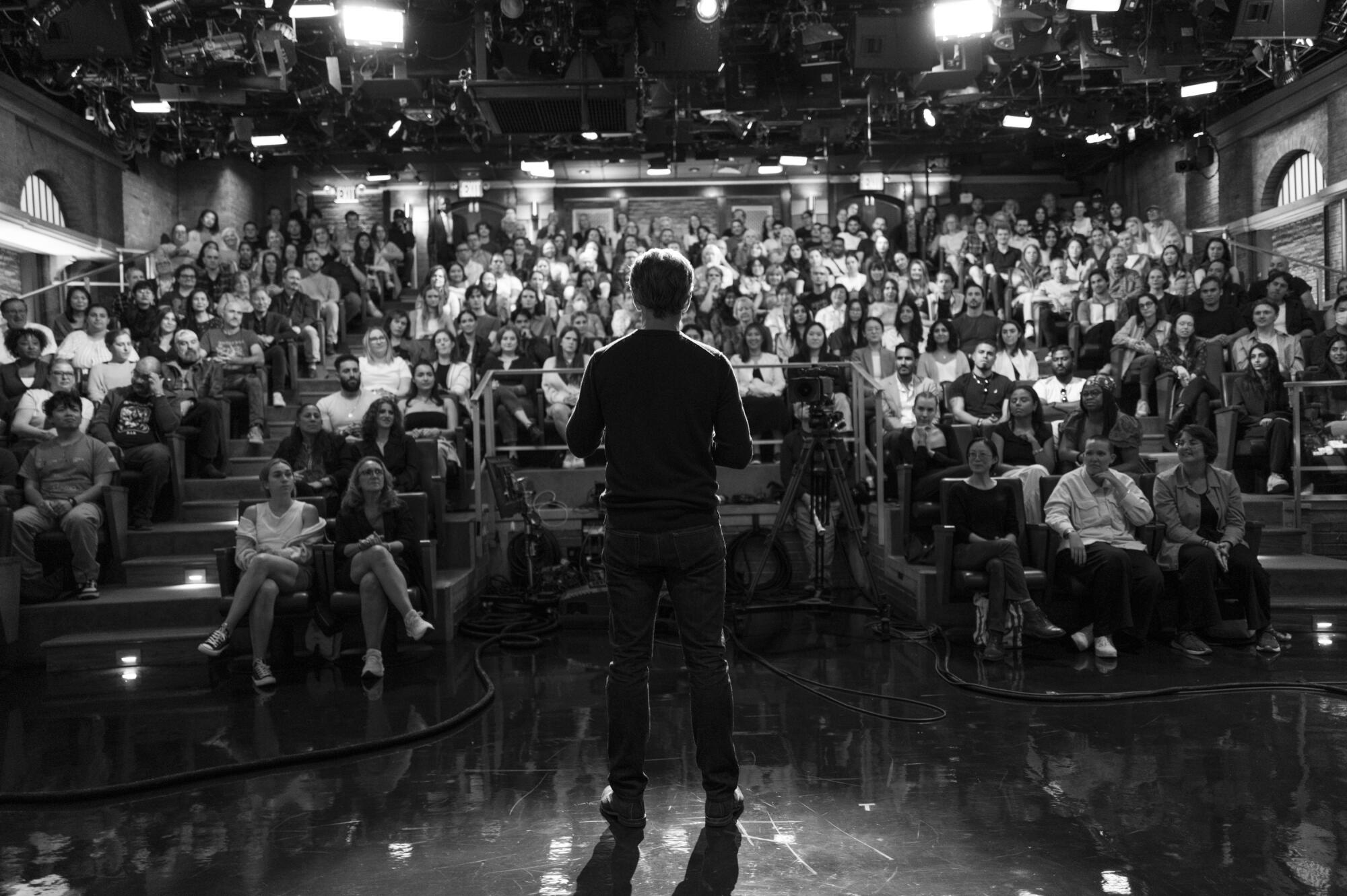
- Share via
New York — It’s a few minutes past 5 p.m. on Monday and Seth Meyers is in his dressing room at 30 Rockefeller Plaza, running through cue cards for the first time since the Writers Guild of America went on strike May 2.
The last time “Late Night With Seth Meyers” was in production, Tucker Carlson had just been fired from Fox News and former President Trump had only been indicted a single time.
A lot has happened in the five months since the show has been off the air, so for their post-strike return, Meyers and his team decided to do an extended version of “A Closer Look,” the recurring segment that takes a deep dive into a subject in the news.
The script for the supersized “Closer Look,” by supervising writer and producer Sal Gentile, runs 80 pages. With his feet on a desk, Meyers sits facing Wally Feresten, who creates the handwritten cue cards for every episode of “Late Night” and “Saturday Night Live.”
The host looks at the massive stack of posterboard in Feresten’s left hand, and asks how many cards he’s prepared for the night — anticipating a record.
As a kid, Wally Feresten longed to write for television.
“Well over 250,” Feresten replies, joking that he had to cut down a tree in his backyard to make the cue cards.
“When your wife hears the chain saw, she goes, ‘SAL!’” says Meyers, feigning the voice of an indignant woman.
Meyers returns to the task at hand, racing through material updated to include Trump’s combative appearance earlier that day in a Manhattan courtroom. Gentile, longtime producer Michael Shoemaker and head writer Alex Baze are in the room making revisions on the fly.
A joke about Rep. Lauren Boebert getting “horned up” at “Beetlejuice the Musical” is reworked because John Oliver had a similar punchline on Sunday’s “Last Week Tonight.” They tinker with the wording of a bit about a (non-existent) podcast hosted by ex-presidents to help Meyers land his wobbly Jimmy Carter impression. All the while, Feresten continues to mark up the cue cards with a Sharpie — crossing out a word here, adding a red underline for emphasis there — before handing it to a young assistant over his right shoulder.

An hour later, it’s showtime. Meyers — dressed in a black sweater and jeans, a more casual look he has sported since the pandemic — takes to the stage and spends a few minutes speaking off the cuff to the audience before the taping begins. “We haven’t done our show for five months and I’m just mostly so happy to be with you here tonight,” he says. “You remember in ‘The Shawshank Redemption,’ the character Brooks who was in prison so long he didn’t know how to be out of prison? That’s me when I don’t have this office to come to.”
Meyers also notes that the special, guest-free episode required more cue cards than they have ever used in “Late Night” history. “The cost of that many cards? I just heard — no Christmas tree at Rockefeller Center.”
Once the cameras are rolling, Meyers takes a few minutes to address the strike, which he calls a “very necessary labor stoppage,” and earnestly thank the WGA negotiating committee, the “Late Night” crew, his family and fellow late-night hosts for their support over the last few months.

Then, it’s time to get back to comedy: Meyers blazes through the three-act “Closer Look,” which begins with a breathless recap of the wild events of the last few months — which Meyers, already a fast talker, delivers at an accelerated pace, making him sound like the guy from those 1980s Micromachines ads.
Jokes about the New York Jets, the people of Philadelphia, the garish Mar-a-Lago bathroom Trump allegedly used to store classified documents and My Pillow CEO Mike Lindell‘s hostile deposition that receive a boisterous response from the audience. He nails impressions of everyone from Cousin Greg from “Succession” to Rudy Giuliani. Even his Carter works, thanks to retooling by Gentile, who confers with Meyers off-camera between segments. Alas, the goldenrod pun is less successful, but Meyers doesn’t flub a single line from any of the 250-plus cue cards.
During the final ad break, Meyers fields questions from the audience — a consolation to fans since there are no celebrity guests.
They ask about “Strike Force Five,” the podcast he has been co-hosting with late-night peers Oliver, Jimmy Fallon, Jimmy Kimmel and Stephen Colbert, the stories he wished he’d been able to cover during the strike (Boebert and “Beetlejuice,” obviously), and why he uses handwritten cue cards instead of a teleprompter. (“Every morning, Wally shows me a picture of his kids and says, do you really want me to tell them that dad has been replaced by a machine?”)
To close the show, Meyers brings Feresten — and his giant stack of cue cards — onstage, eliciting applause so loud it was difficult to hear what the host was saying.

The taping wraps just after 7:30 p.m. In a green room backstage, Meyers tears open a bag of chocolate candy and reflects on his first night back. “It definitely felt a little strange, but mostly wonderful. It was great to come back and do a show that was entirely about the writing, because that is the piece of it that I’ve missed the most,” he says. Though he didn’t visibly stumble during the show, Meyers admits he felt rusty. “I was halfway through the first act of ‘A Closer Look’ before I remembered to be loose.”
Like virtually every other talk show on TV, “Late Night” went dark as soon as the strike began May 2. Meyers said he realized fairly quickly that the strike would not be resolved swiftly because the two sides were not even in conversation. An issue that particularly concerned him in the negotiations was the use of artificial intelligence. “Nobody can predict where it’s going, but you had to have some acknowledgment that there was a thing to be discussed,” he says. (The new WGA contract limits how AI can be used in writers’ rooms.)
“Late Night” has faced setbacks before: during the early days of the COVID lockdown, the show broadcast from an attic-turned-playroom in Meyers’ country home using an iPad for a camera, and once they were back in Studio 8G at Rockefeller Center, there were many more months without an audience. But the uncertainty of the writers’ strike was different, Meyers says: “It was only the people you talk to in show business who felt this, so ultimately you felt like a ghost haunting a house that nobody can see. COVID was also a far worse time to live through, but we got to keep doing the show. Creatively, we had an outlet, whereas that wasn’t available this time.”
What is it like for homebound writers and host to make late-night comedy in the time of coronavirus? ‘Not normal,’ says Seth Meyers.
Even his three kids showed little willingness to indulge his performative streak, Meyers says: “I can’t get any traction with my kids at all. They won’t even let me do voices when I read Harry Potter — and I do a very passable British accent.”
Meyers says he stayed busy in the downtime, doing stand-up gigs, making a podcast called “Family Trips” with his brother Josh and co-hosting “Strike Force Five,” which raised money for show staffers who were out of work because of the strike. He and his fellow late-night hosts were in close communication about the strike even before it began, and he credits them for not breaking ranks. (During the 2007-08 strike, hosts Conan O’Brien and Jay Leno returned to production without writers.) The five hosts coordinated their return as well: Oliver’s show was back Sunday and the rest Monday.
“Colbert reached out in the weeks leading up to [the contract expiration on] May 1, stressing the importance — based on what happened during the last strike — of being able to talk, having good communication and the importance of us having host solidarity,” he says. “Once we made it clear that we were all on the same page, I don’t think anybody ever attempted to exert pressure on us to go back because they knew it would have to be all five of us. Nobody was gonna go back without the other four.”

About a month ago, when it seemed like negotiations would resume and an end to the strike might be in sight, Meyers floated the idea of an all-”Closer Look” episode with Shoemaker, his producer, “knowing Sal would probably write a really long one, whether we gave him the time or not.” Gentile got back to work Wednesday after the strike lifted, and worked through the weekend producing a script, which in the end mostly focused on the events of the last week — including the narrowly averted government shutdown. “Sal writes with an almost journalistic structure: here’s a thesis statement, here’s my supporting facts and here’s a conclusion. And so that allows you to get a lot of material,” Meyers says. “Then my job is to layer in extra jokes. Some work better than others. Look at ‘goldenrod.’ The audience got it right.”
For Meyers, it didn’t really feel like he was back at work until he went on stage.
“That’s where it felt official that the show was back. Seeing actual people who took time out of their day to come here — it hits home.”
More to Read
The complete guide to home viewing
Get Screen Gab for everything about the TV shows and streaming movies everyone’s talking about.
You may occasionally receive promotional content from the Los Angeles Times.






